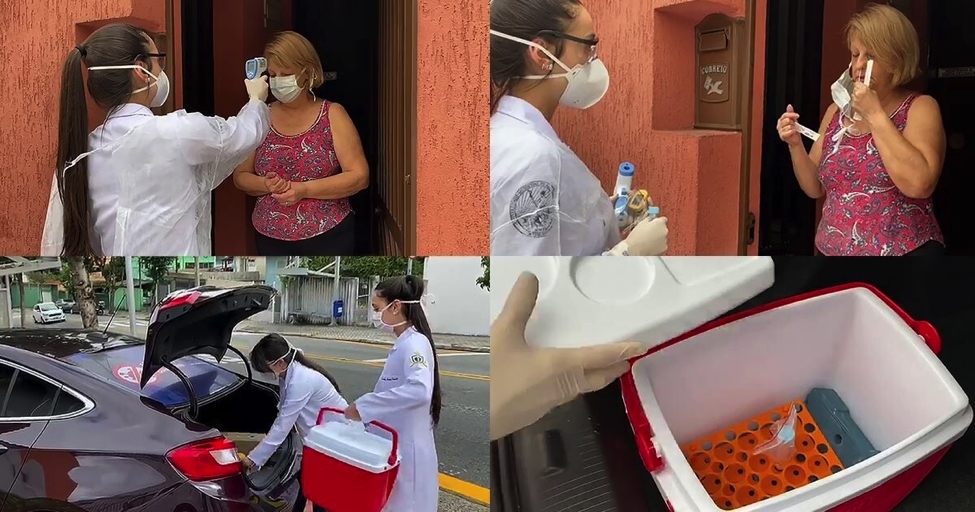

Brazilian researchers monitoring the population of metropolitan São Paulo have reported atypical cases in which SARS-CoV-2 continues to replicate in the organism for longer than the recommended isolation period (photos: São Caetano Corona Program)
Brazilian researchers monitoring the population of metropolitan São Paulo have reported atypical cases in which SARS-CoV-2 continues to replicate in the organism for longer than the recommended isolation period.
Brazilian researchers monitoring the population of metropolitan São Paulo have reported atypical cases in which SARS-CoV-2 continues to replicate in the organism for longer than the recommended isolation period.

Brazilian researchers monitoring the population of metropolitan São Paulo have reported atypical cases in which SARS-CoV-2 continues to replicate in the organism for longer than the recommended isolation period (photos: São Caetano Corona Program)
By Karina Toledo | Agência FAPESP – Studies conducted at the University of São Paulo’s Institute of Tropical Medicine (IMT-USP) in Brazil show that SARS-CoV-2 can remain active in patients with mild symptoms for longer than the 14-day isolation period recommended in Brazil.
In an article posted to the preprint platform medRxiv and currently undergoing peer review, a research group led by Maria Cassia Mendes-Correa describes two cases involving women in their fifties living in São Caetano do Sul, a city in metropolitan São Paulo.
One woman first contacted the health service in mid-April 2020 and reported some 20 days of symptoms including a dry cough, headache, weakness, muscle pain, and joint pain. Twenty-two days after the onset of symptoms, a nasopharyngeal swab tested positive for SARS CoV-2 by the RT-PCR method. She later reported nausea, vomiting, and loss of taste and smell. A second nasopharyngeal swab test performed 37 days after the onset of symptoms was also positive for SARS CoV-2. Most symptoms had disappeared by mid-May, although she still complained of headache and weakness.
The other patient experienced fever, headache, sore throat, cough, weakness, a runny nose, joint and muscle pain, and nausea in early May. A first RT-PCR test performed five days after the onset of symptoms was positive. Her symptoms persisted and a second nasopharyngeal swab test performed on the 24th day again confirmed the presence of viral RNA. The patient remained symptomatic for about 35 days.
“Because these were atypical cases, the nasopharyngeal swab samples collected for diagnosis were sent to IMT-USP for more detailed analysis. The material was inoculated into cultured epithelial cells, and a series of different tests confirmed that the virus present in them was still viable. It was capable of replicating and infecting other people,” Mendes-Correa told Agência FAPESP.
Both patients were participants in the São Caetano Corona Program, an online platform offering COVID-19 care to all residents of the city via remote monitoring and home visits to collect samples for diagnosis. The initiative involved the city government, the Municipal University of São Caetano do Sul (USCS), a startup called Modular Research System (MRS), and IMT-USP.
With FAPESP’s support, Mendes-Correa and her group followed 50 other participants in the program for six weeks to find out how long the virus persisted in the organism. Samples of saliva, urine, feces (anal swabs), nasopharyngeal secretion and blood were collected every week. All the material was sent to IMT-USP and inoculated into cell cultures to verify the presence of active viruses.
“The analysis showed that viral RNA remained detectable for the longest in saliva nasopharyngeal secretion,” Mendes-Correa said. “In 18% of the volunteers, the RT-PCR test on these types of sample remained positive for up to 50 days, and 6% of these remained transmissible [with the virus still multiplying] for 14 days.”
In her judgment, therefore, the ten-day isolation period currently recommended by the US Centers for Disease Control (CDC) may be insufficient to avoid transmission of the novel coronavirus and new cases of COVID-19.
Immunocompromised
Another arm of the research conducted at IMT-USP entails the monitoring of immunocompromised individuals infected by SARS-CoV-2. Ten volunteers have been included in the project to date, and one has had an active infection for more than six months.
“The patient had a bone marrow transplant before being infected. Analysis shows that the viral load in his organism is high and the virus is highly infectious. He, therefore, remains isolated even now, a long time after symptom onset,” Mendes-Correa said.
Cases like this require close monitoring, she added, as they offer ideal conditions for the emergence of potentially more aggressive viral variants. “The fact that the virus continues to replicate in the organism for such a long time favors the selection of mutations that give it advantages. This patient is significantly immunocompromised and is being closely watched in accordance with a research protocol, but it’s also necessary to pay special attention to that part of the general population with milder immunosuppression, such as people with autoimmune diseases [who take immunosuppressants], for example.”
Republish
The Agency FAPESP licenses news via Creative Commons (CC-BY-NC-ND) so that they can be republished free of charge and in a simple way by other digital or printed vehicles. Agência FAPESP must be credited as the source of the content being republished and the name of the reporter (if any) must be attributed. Using the HMTL button below allows compliance with these rules, detailed in Digital Republishing Policy FAPESP.




